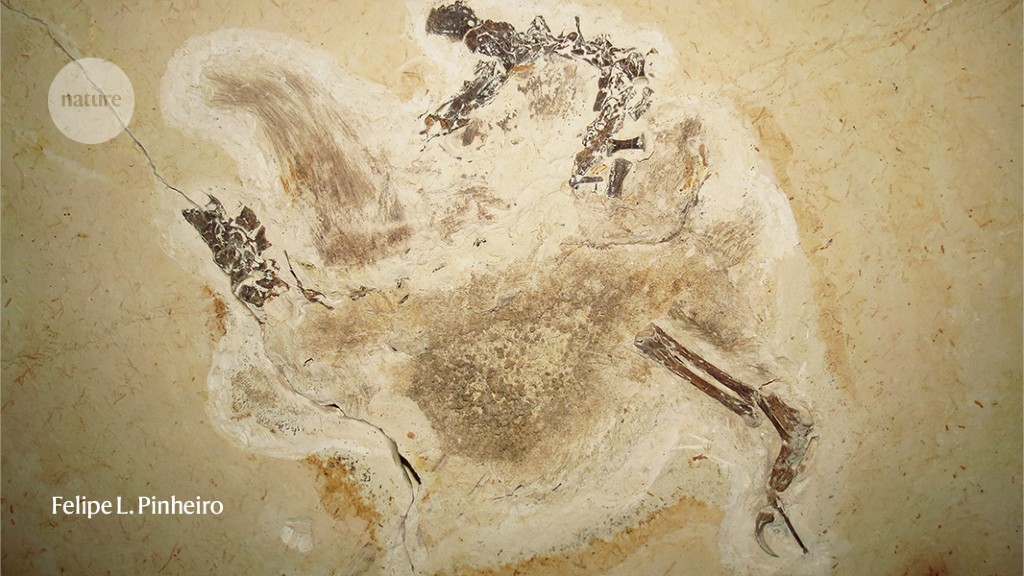Prized dinosaur fossil will finally be returned to Brazil

Following theft accusations, a German museum is set to hand over a one-of-a-kind dinosaur specimen with feather-like structures

The Ubirajara jubatus fossil is a holotype — a species-defining, model specimen.credit: Felipe L. Pinheiro
After more than two years of negotiations, a controversial fossil is on its way home. The specimen — representing the first non-avian dinosaur with feather-like structures found in South America — will return to Brazil in June, according to the Guimarães Rosa Institute in Brasília, an agency housed in Brazil’s Ministry of Foreign Affairs that is focused on cultural and educational diplomacy.
The 110-million-year-old fossil, currently at the State Museum of Natural History Karlsruhe in Germany, has been at the heart of a dispute between Brazilian and German officials since December 2020. This was when a team of palaeontologists in Germany, Mexico and the United Kingdom published a research paper describing the specimen and its dinosaur, Ubirajara jubatus, in the journal Cretaceous Research1. The researchers had obtained the fossil in the 1990s from the Araripe Basin in Brazil and then stored it at the German museum.
However, Brazil has a law, enacted in 1942, stating that fossils are federal property and cannot be removed from its borders without permission. The authors of the paper said that they had a permit from a Brazilian mining official allowing the Ubirajara specimen to be exported. Rafael Rayol, a public prosecutor in Juazeiro do Norte, Brazil, who is working on the Ubirajara case, told Nature that there was no explicit donation of the fossil when it was removed from Brazil. “There was a donation of boxes containing some unknown fossil material,” he said. “In theory, it is possible Ubirajara was in those boxes — in any case, the authorization issued by Brazil’s former Mineral Production Department in the 1990s did not follow the legal processes.”
Back and forth
The Ubirajara fossil’s road back to Brazil has been long and winding.
Following the paper’s publication in Cretaceous Research, an online campaign with the hashtag #UbirajaraBelongsToBrazil called for the specimen’s return, citing palaeontological colonialism, in which scientists from wealthy nations take fossils from low- and middle-income nations. Because it is the only known specimen of its kind and is well preserved, researchers consider the Ubirajara fossil to be a holotype — a gold-standard specimen used to describe a new species.
This artist’s rendering shows what Ubirajara jubatus, with feather-like spears protruding from its shoulders, might have looked like.Credit: Pavel Galvan
Holotypes, in particular, are further protected by a 1990 Brazilian law that forbids their export from Brazil. In light of the legal issues surrounding the case, Cretaceous Research eventually withdrew the paper.
In September 2021, the Karlsruhe museum said it would not repatriate the specimen. The public prosecutor’s office in Brazil then filed an official request with the German government, asking for the fossil’s return. But the German Federal Foreign Office issued a note in April of last year stating that the country would not release it.
In July 2022, however, the German state of Baden-Württemberg, where the Karlsruhe museum is located, ruled in favour of repatriation, in response to a proposal from the state’s then-science minister Theresia Bauer.
According to Gustavo Bezerra, a councillor at the Guimarães Rosa Institute, the Ubirajara specimen is due to be handed over in June to Brazil’s National Museum in Rio de Janeiro, during a visit by a German official. This museum burnt down in 2018 after an electrical failure in its air-conditioning system and is now being rebuilt.
“The museum wants the piece as a contribution to its reconstruction,” says Alexander Kellner, its director. But there is still some uncertainty. The museum hasn’t had contact so far with the German government regarding the transaction, Kellner says.
Brazil’s Ministry of Science, Technology and Innovation told Nature that it had designated the National Museum to receive the fossil. The German embassy in Brasília told Nature that, at the moment, Brazilian and German partners are engaging in “multi-level conversations” about how and in what context the delivery will take place.
A new era?
The Brazilian scientific community is hopeful that the Ubirajara fossil’s return will launch a new chapter for palaeontology worldwide.
“The return of this material means a lot,” says Aline Ghilardi, a palaeontologist at the Federal University of Rio Grande do Norte in Natal, Brazil, and one of the researchers who spearheaded the #UbirajaraBelongsToBrazil campaign.
It is an “important message against science colonialism in the twenty-first century, and opens a strong precedent for more fossils to go back to their countries of origin”, she says. But she worries that there are still battles to be fought over “internal colonialism” — in which institutions in richer regions of a country exploit poorer ones. In particular, she is concerned about the Ubirajara fossil going to the National Museum rather than the Plácido Cidade Nuvens Palaeontological Museum in Santana do Cariri, which is near the Araripe Basin where the specimen was collected.
To Hermínio Araújo, a palaeontologist at the Federal University of Rio de Janeiro who is also president of the Brazilian Society of Palaeontology, the fossil’s return sends another important message: efforts such as the one to return Ubirajara are important, and show the power that a community can have when it “speaks out and denounces such situations”.
doi: https://doi.org/10.1038/d41586-023-01603-y
This story originally appeared on: Nature - Author:Meghie Rodrigues


















